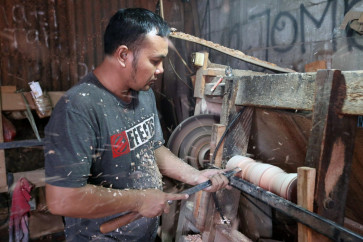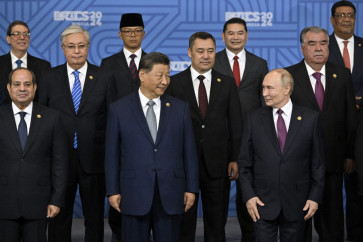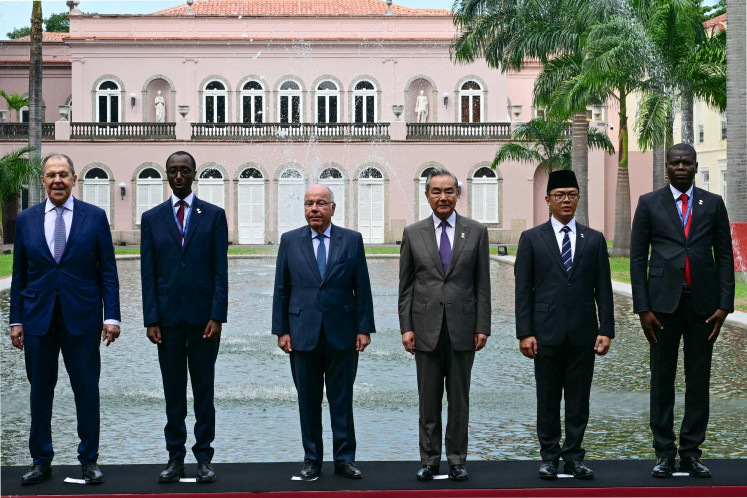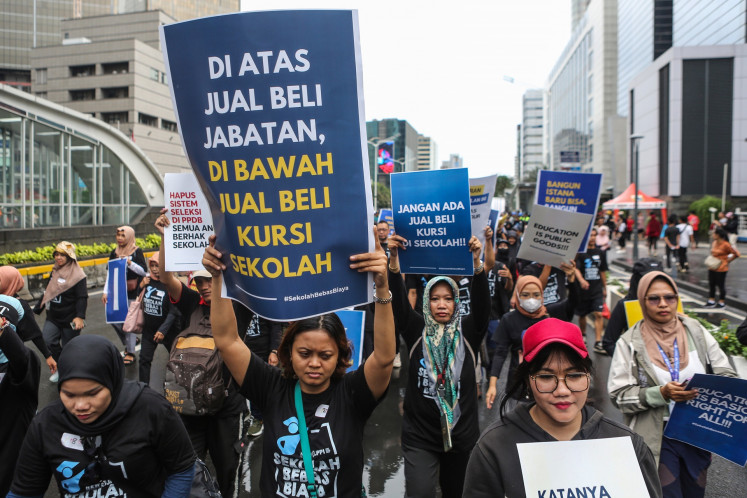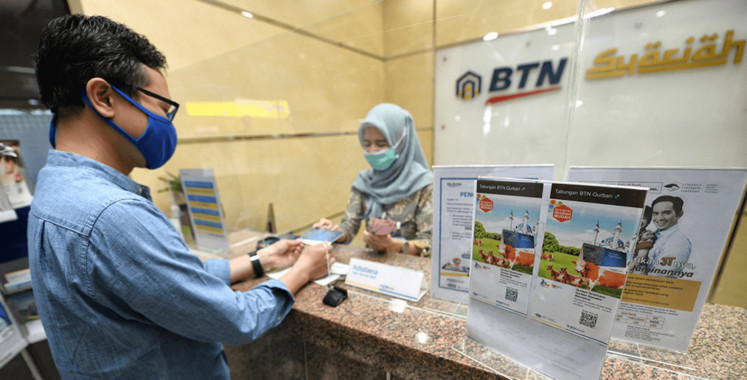Entang Wiharso: Visualizing concept & contemplation
The Other Dream: I Love You Too Much by Entang Wiharso (JP/DMR)Entang Wiharso is an avid observer of chaos who works with a variety of materials to tell his stories
Change text size
Gift Premium Articles
to Anyone
 The Other Dream: I Love You Too Much by Entang Wiharso(JP/DMR)" border="0" height="341" width="512">The Other Dream: I Love You Too Much by Entang Wiharso (JP/DMR)
The Other Dream: I Love You Too Much by Entang Wiharso(JP/DMR)" border="0" height="341" width="512">The Other Dream: I Love You Too Much by Entang Wiharso (JP/DMR)Entang Wiharso is an avid observer of chaos who works with a variety of materials to tell his stories.
The prominent Indonesian contemporary artist recently collaborated with Australian contemporary and feminist artist Sally Smart and showcased their individual artwork in Jakarta.
Although the opening day of the exhibition was marred by a terrorist attack nearby, Entang Wiharso remained calm and composed as he answered a number of questions related to terrorism and the exhibition.
âPersonally, I feel afraid, but I will not get trapped in that fear. We have to stand up to show that we have hopes, expectations and dreams that we try to build,â he said.
Entang said the terror attack actually made him feel weird, especially because some of his artwork in the exhibition happened to highlight the issue of tolerance.
He said human figures that transformed into animals as seen in the work Chronic Satanic Fences (2010) showed how intolerant people became worse than animals, as they committed violence only to satisfy their desires.
It was not easy to become a tolerant person, he said, as many people tended to hide their feelings. In his experience, tolerance requires a learning process and awareness, which can only be achieved when people are willing to mingle a lot, join discussions and have an open mind.
âI was raised in a Muslim family. My mother is a devout Muslim. It was not easy to reach my current position because I had to learn a lot. I often stumbled in my effort to become a tolerant person,â he said.
Born in Tegal, Central Java, in 1967, the multi-talented artist started his journey in the art world by painting. He picked up the first prizes in a number of painting competitions when he studied fine art and painting at the Indonesian Art Institute (ISI) in Yogyakarta. Since then, he has received other awards and many fellowships, grants and residencies, including a residency at The Watermill Center in the US and a residency and grant from Gertrude Contemporary in Melbourne, Australia.
The Other Dream: I Love You Too Much by Entang Wiharso (JP/DMR) Entang Wiharso is an avid observer of chaos who works with a variety of materials to tell his stories. The prominent Indonesian contemporary artist recently collaborated with Australian contemporary and feminist artist Sally Smart and showcased their individual artwork in Jakarta. Entang's artwork has been presented in various solo and group exhibitions across the globe. His solo exhibitions last year included Untold Stories in Dirimart, Istanbul, Turkey, Never Say No in the Singapore Tyler Print Institute, Perfect Mirror in the Bernier/Eliades Gallery in Greece and Entang Wiharso in the Marc Straus Gallery in New York, the US. 
Although the opening day of the exhibition was marred by a terrorist attack nearby, Entang Wiharso remained calm and composed as he answered a number of questions related to terrorism and the exhibition.
'Personally, I feel afraid, but I will not get trapped in that fear. We have to stand up to show that we have hopes, expectations and dreams that we try to build,' he said.
Entang said the terror attack actually made him feel weird, especially because some of his artwork in the exhibition happened to highlight the issue of tolerance.
He said human figures that transformed into animals as seen in the work Chronic Satanic Fences (2010) showed how intolerant people became worse than animals, as they committed violence only to satisfy their desires.
It was not easy to become a tolerant person, he said, as many people tended to hide their feelings. In his experience, tolerance requires a learning process and awareness, which can only be achieved when people are willing to mingle a lot, join discussions and have an open mind.
'I was raised in a Muslim family. My mother is a devout Muslim. It was not easy to reach my current position because I had to learn a lot. I often stumbled in my effort to become a tolerant person,' he said.
Born in Tegal, Central Java, in 1967, the multi-talented artist started his journey in the art world by painting. He picked up the first prizes in a number of painting competitions when he studied fine art and painting at the Indonesian Art Institute (ISI) in Yogyakarta. Since then, he has received other awards and many fellowships, grants and residencies, including a residency at The Watermill Center in the US and a residency and grant from Gertrude Contemporary in Melbourne, Australia. 
The down-to-earth artist is known for his penchant for cooking up a concept that combines traditional philosophy, myths, his past life experiences and today's social situation. He said his current artwork could be inspired by events that happened several months, or even years, ago.
His works tell a visual story that is rich in symbolism, such as long dog tongues, humans with demonic faces or animals' feet, lengthy intestines and machines inside human bodies. He can also be strikingly critical of unethical behavior such as human greed as shown in the installation titled Under Inheritance: Endless Feast Table (2014-2015), which displays four statues whose heads are connected by aluminum cables devouring a giant decorative koi fish on a table.
For Entang, the aesthetic value is just one of many aspects in art. He prefers to treasure the impact of his artwork, how it can ignite conversation, enlighten viewers and connect people.
'In my experience, art can become a door to new friendship. I held my first exhibition in Rhode Island to get to know the community there. Numerous people showed up, which showed that art can open up diplomacy,' he said.
Looking back, the father-of-two realized his artistic talent was still in elementary school. Back then, his early drawings were of puppets and superheroes.
'When I was small, I had to save money to buy pens and pencils. I got access to watercolor paints only when I was about to enter junior high school,' he said.
When he was a teenager he received a paid commission to design a mural. Entang said he used the small fee to buy more paints for another project, a practice that he still dutifully follows as an artist today.
'When I get public appreciation or sales from my collection, I use the money to create another artwork because creating them is not cheap. Presenting what I want is like a commitment for me. It is priceless and becomes a luxury,' he said.
Entang, who lives with his wife and children, now travels between his main studio in Yogyakarta and the smaller one in the Rhode Island. Yogyakarta has a special place in his heart because he spent his college years in the city. His main studio is located in Kalasan, near the majestic Prambanan Hindu temple and far from the city's hustle and bustle.
'I chose the location because I wanted to become focused and close to a great achievement in civilization. I feel focused and comfortable there. I can go to the city if I want to visit friends and I can filter visitors because they will have to make quite a long journey to my house,' he said.
He said that living near Prambanan provided many impressions and many benefits, such as inspiring him to create his own upgraded relief.
'When I was small, I was always dreaming. This is the time I can execute those dreams, so I had a fundamental reason for choosing it [the location],' he said.
When he experiences artistic block, he goes to his friends' houses, eats something delicious or engages in his hobbies ' cooking and gardening.
'I used to help my mother, who sold food in a warteg [sidewalk food stall]. I also like to explore food, so I can cook various dishes, from warteg dishes to western cuisine,' he said.
Entang is aware of the health and pollution issues, so he carefully selects ingredients and avoids eating excessively. He happily grows vegetables such as chilies, spinach and eggplants in poly bags as a healthy food source. Every summer in Rhode Island he plants tomatoes in his garden.
'Once, I was away after planting my tomatoes. They grew in abundance, so my wife distributed them to our friends,' he said, adding that he also liked to make tomato paste and refrigerate it.
Entang likes to observe the freedom to create art in the US. He believes it is impossible for people to achieve greatness if their creativity is blocked.
'That is why I tell my children that they should not limit their creative energy because whatever professions they choose, be they artists, businessmen or scientists, they all need creativity. Without this element, life will dry up,' he said.
Your Opinion Matters
Share your experiences, suggestions, and any issues you've encountered on The Jakarta Post. We're here to listen.
Thank You
Thank you for sharing your thoughts. We appreciate your feedback.
Share options
Quickly share this news with your network—keep everyone informed with just a single click!
Gift Premium Articles
to Anyone
Share the best of The Jakarta Post with friends, family, or colleagues. As a subscriber, you can gift 3 to 5 articles each month that anyone can read—no subscription needed!
Continue in the app
Get the best experience—faster access, exclusive features, and a seamless way to stay updated.

